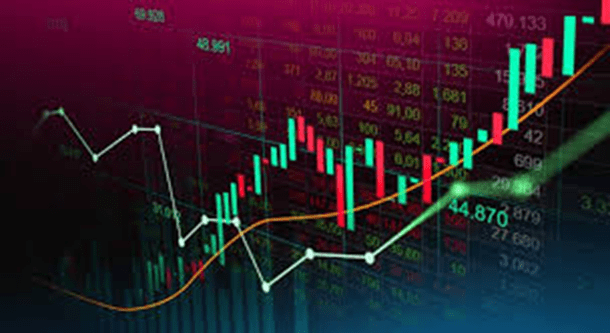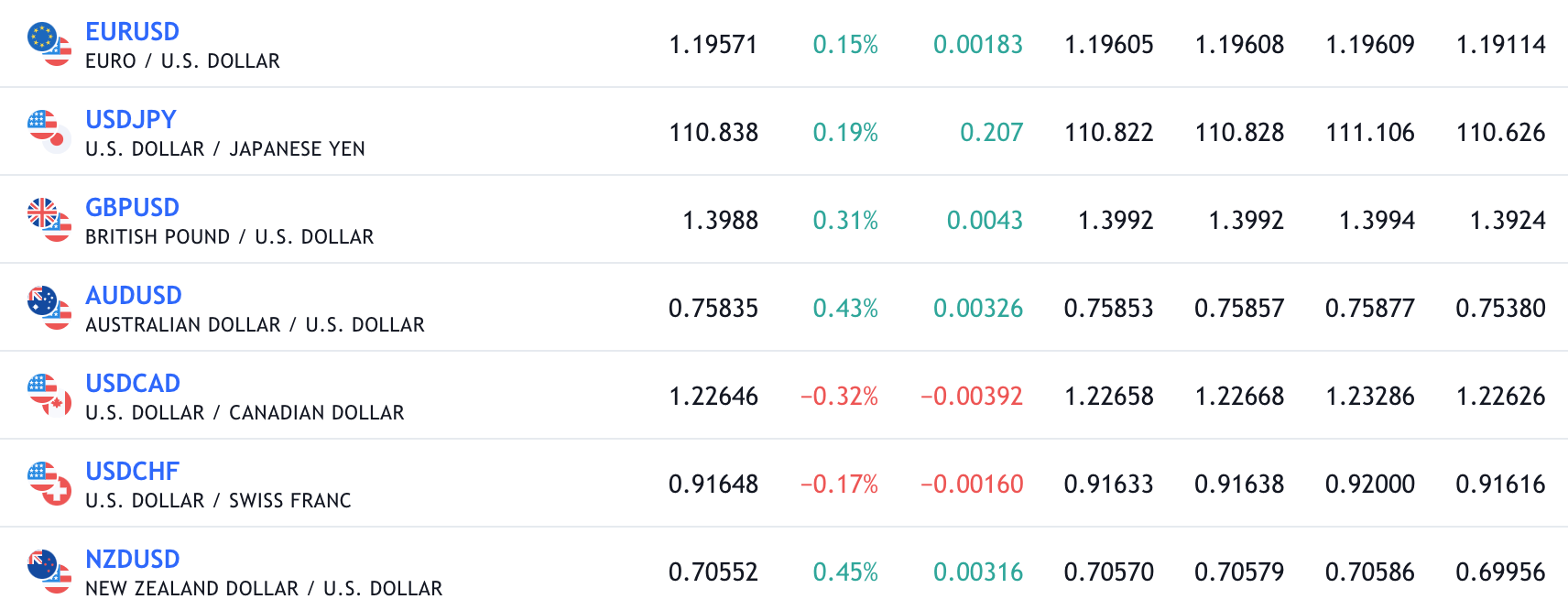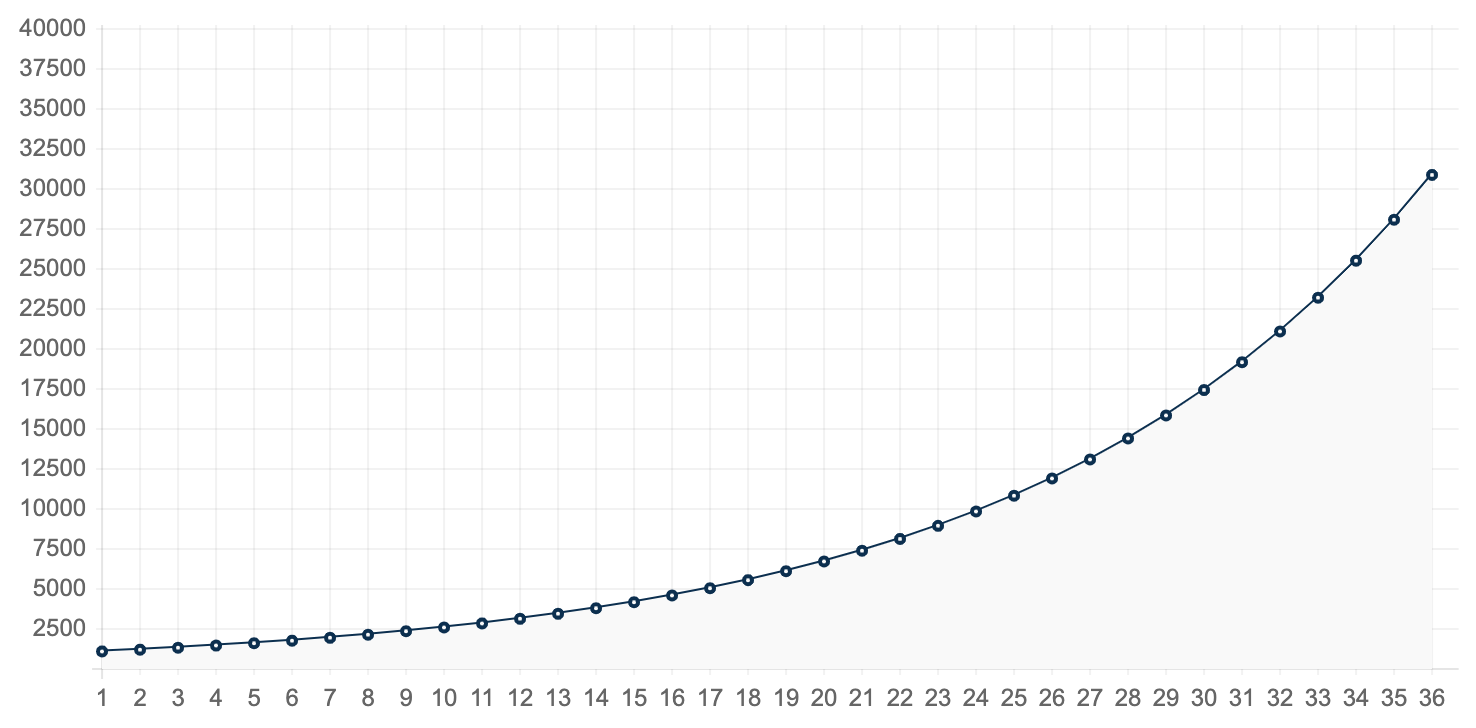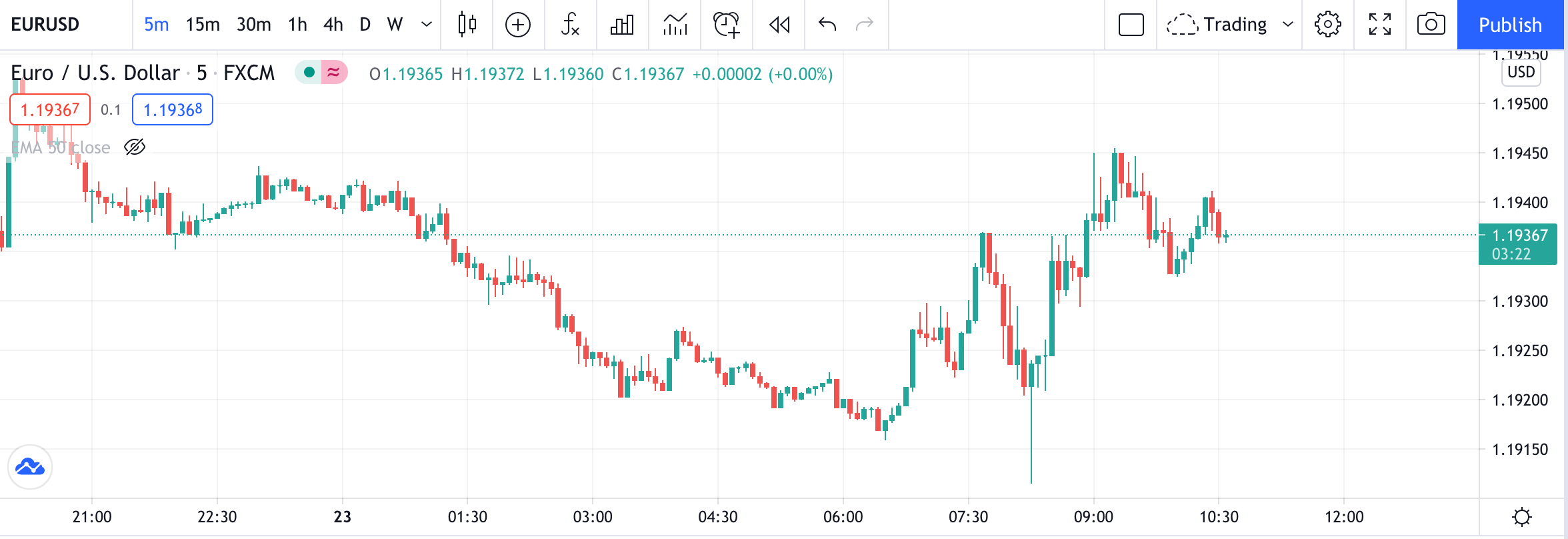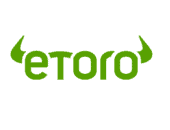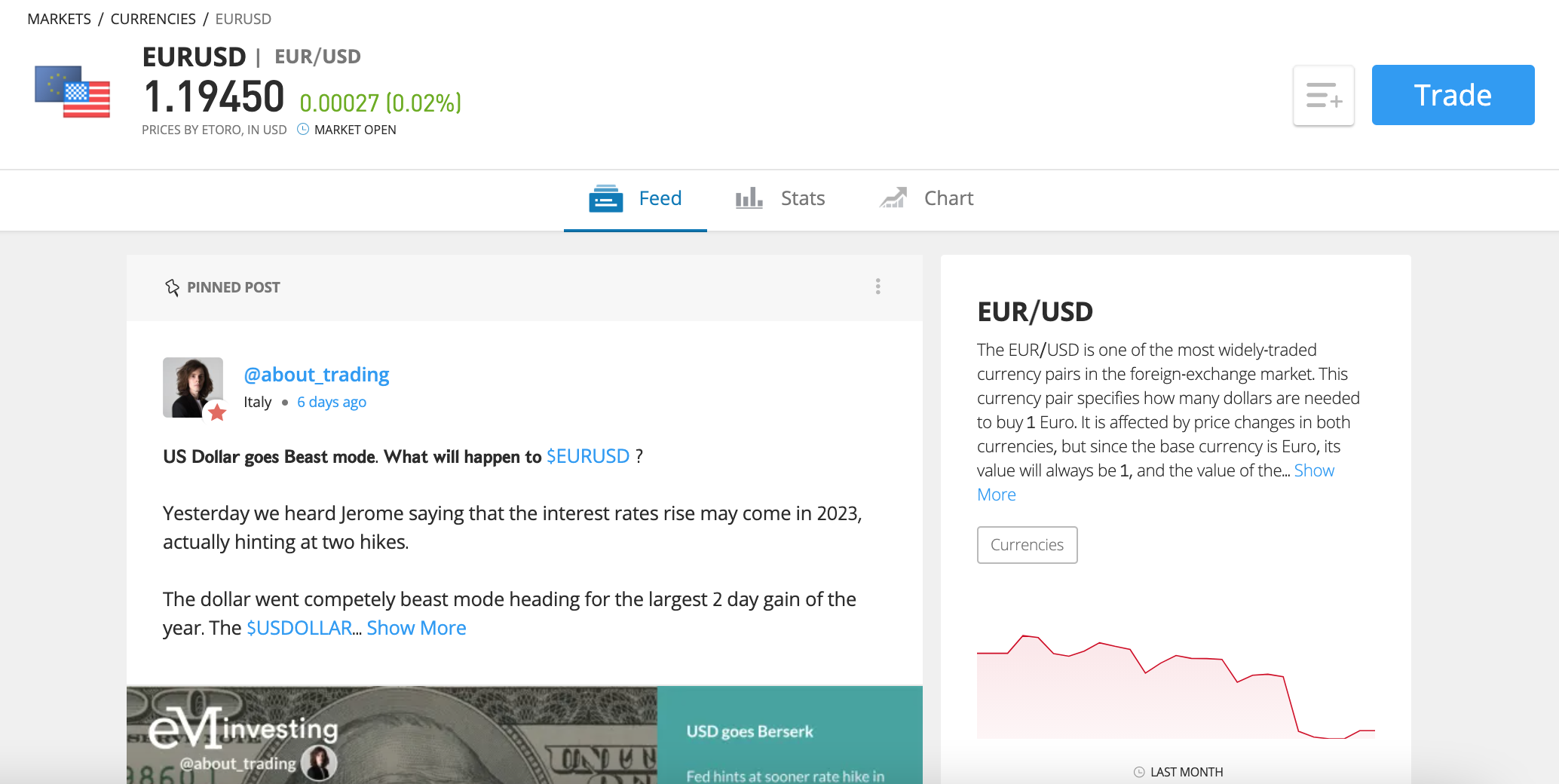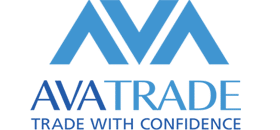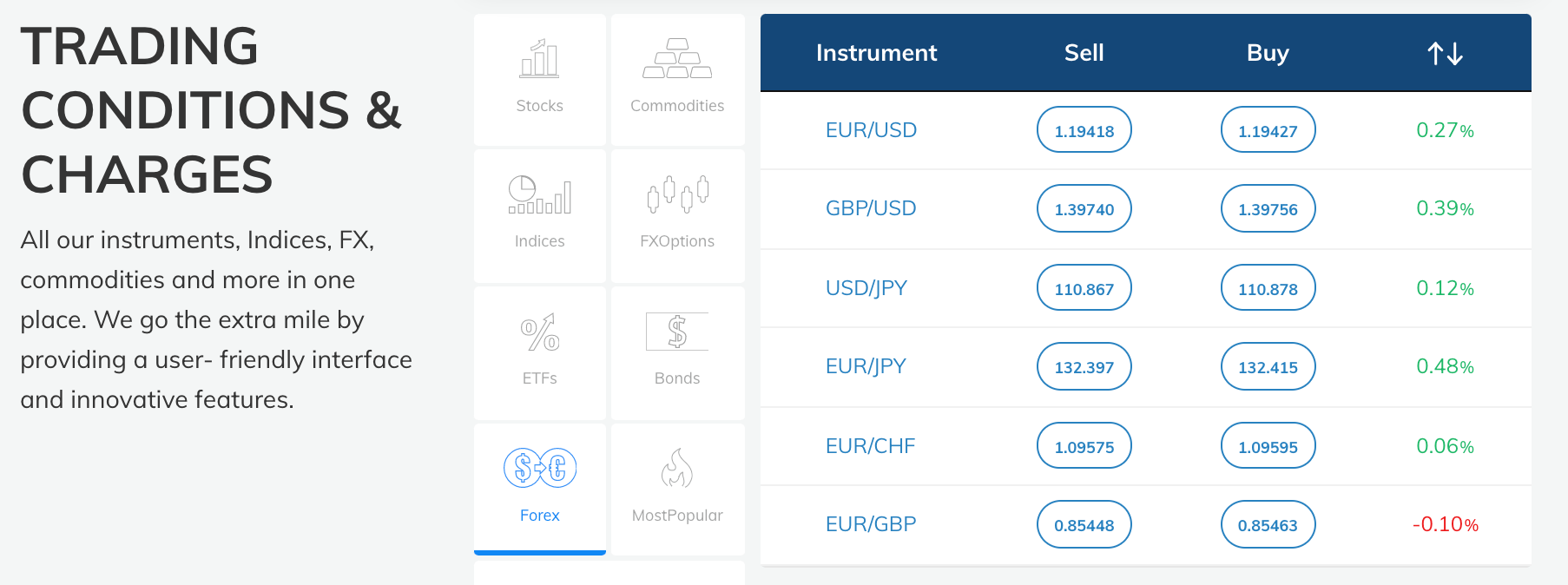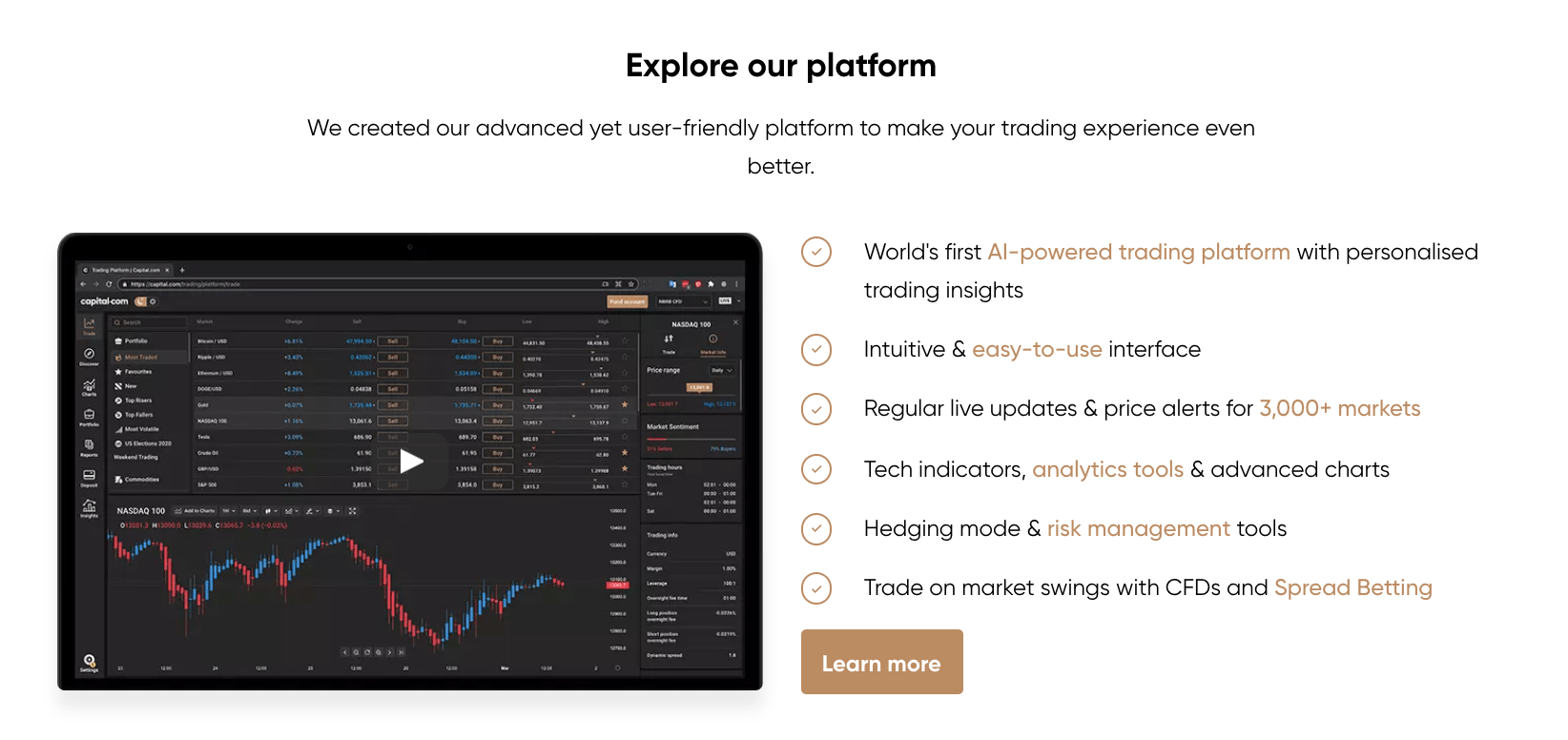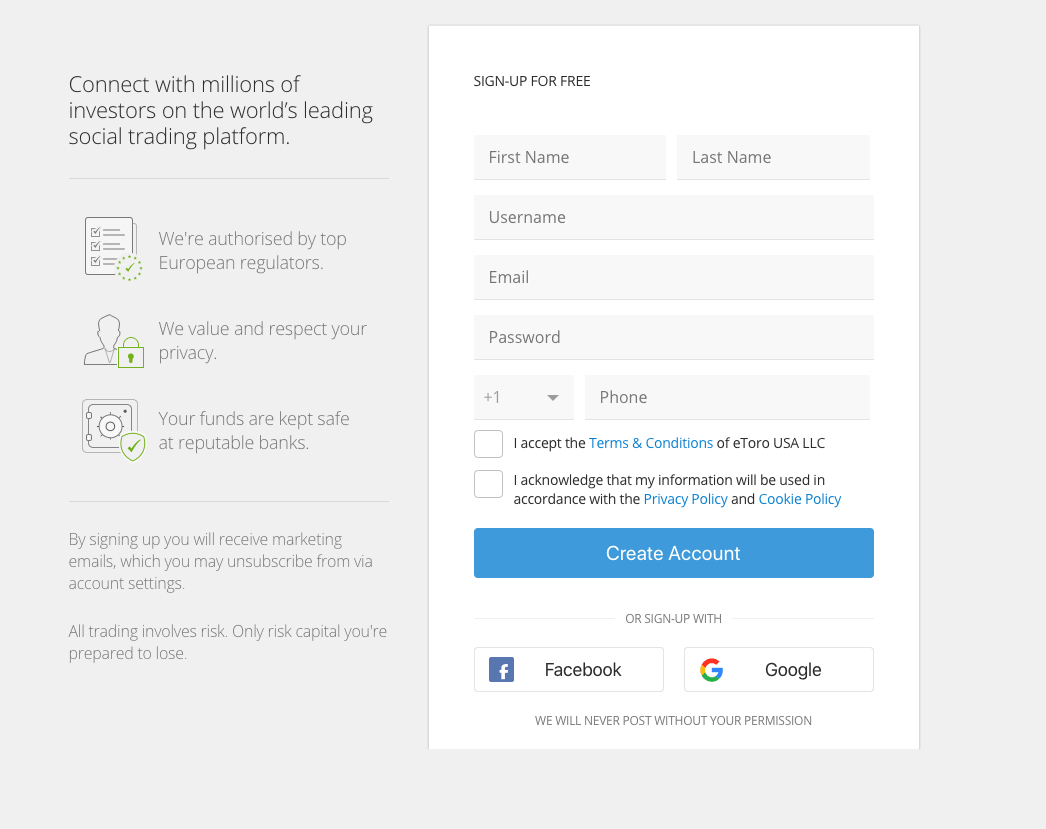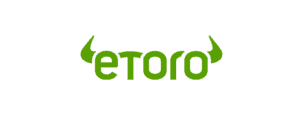Forex Trading for Beginners Guide 2022
The forex market is the largest financial market globally, with more than $6.6 trillion in trading volume occurring every day. Due to the fast-paced nature of the market, many retail traders are drawn to forex trading – and with opportunities to make returns every single day, it’s clear to see why.
This article will act as a Forex Trading for Beginners Guide, covering everything you need to know about the forex market. In addition, we’ll discuss a selection of the best forex trading platforms and show you how to get set up and ready to trade in under ten minutes.
Quick Forex Trading Guide 2022
Are you looking to get started trading the forex market right away? Look no further – by following the four steps below, you’ll be able to streamline the process and begin FX trading as quickly as possible.
- Step 1: Learn the basics – Use online resources such as courses and guides to gain a solid overview of the FX market and how it works.
- Step 2: Develop a strategy – Research various strategies and develop one that will suit your schedule and risk tolerance.
- Step 3: Choose a broker – Open an account with a licensed and reputable broker that will allow you to trade the FX market. We recommend eToro.
- Step 4: Start trading forex – Make a deposit, wait for a viable buy or sell opportunity to arise, and then begin trading the forex market.
What is Forex Trading and How Does it Work?
To be able to make money with forex, you need to begin with having a deep understanding of how forex trading works. Forex trading is the process of exchanging one currency for another through the financial markets. This can be as simple as exchanging pounds for euros before you go on holiday – but when we discuss forex trading in an investment sense, it tends to refer to the process of speculating on currency values for potential gains.
According to The Tokenist, the forex market is the largest and most liquid market on earth, with over 170 currencies being traded worldwide. Due to the size and accessibility of this market, retail traders worldwide will enter the market every day and attempt to make returns on their capital. Notably, retail traders only make up a tiny percentage of global trading volume – most of which comprises banks and large financial institutions.
As the forex market is so large and there are so many moving parts, we’ll break down some of the critical components below, helping you understand how it works and how you can get involved.
Forex Currency Pairs
The first thing to understand about the forex market is that when you trade a currency, you’ll actually be trading a currency pair. This may seem confusing at first, but it simply means you are trading one pair against another. Currency pairs are quoted as a ‘base’ currency and a ‘variable’ or ‘quote’ currency. For example, if you were trading the Euro against the dollar, it would be quoted as ‘EUR/USD’.
Forex trading works by traders speculating on a rise in the base currency against a fall in the variable/quote currency. To provide an example, if you expected the Euro to appreciate against the dollar, you’d open a buy position in the EUR/USD currency pair. If the Euro went on to rise in value whilst the dollar declined, you’d be in profit. You can read our EUR/USD forecast to learn more.
There are many currency pairs to trade, ensuring traders have lots of variety in the market. Major pairs are the most liquid and are the ones that are most traded by both retail and professional traders. In addition, minor pairs are less traded but can also showcase some great opportunities. Finally, exotics are currency pairs that are rarely traded and have pretty low liquidity – meaning these are best saved for advanced traders.
Forex Trading Hours
The forex market operates 24 hours per day, five days per week. As the market is global, there will be certain times when markets are slow or certain days over the weekend where markets are closed.
The forex market opens at 5pm EST on Sunday afternoons and closes at 4pm EST on Friday afternoons. Between these times, the forex market is open to all participants across the world through different ‘sessions’, such as the London, New York, and Asian sessions. These relate to the time of day for each location and the level of trading activity that corresponds.
CFDs vs Spot vs Futures vs Options
There are numerous ways to trade the forex market, ensuring that every investor type is catered to. The list below summarises some of the main ones:
- CFDs – CFD stands for ‘Contract for Difference’ and is a contract that provides exposure to fluctuations in the value of an asset without having to own the underlying asset. Many brokers will offer CFDs for FX trading to ensure a seamless trading experience and the ability to use leverage.
- Spot – Spot trading means buying/selling a currency ‘on the spot’ at the current market price. Most FX trading is conducted in this manner as spreads are narrower, allowing for quick trades.
- Futures – Futures are a type of contract where two parties agree to exchange a currency for a specific price at a particular future date. Traders can use these contracts for both speculative and hedging purposes.
- Options – Options contracts give traders the right (but not the obligation) to buy/sell a currency at a specified date in the future at a pre-determined price. Again, these can be used for both speculative or hedging purposes, e.g. if you do forex options trading.
Forex Pips & Spreads
Forex trading for beginners means understanding what pips are and what the spread is. Put simply, pips are just a unit of measurement used to determine the change in the value of a currency. Pip stands for ‘percentage in point’ and, in most pairs, pips will correspond to a change in the fourth decimal place on a currency quote. For example:
- EUR/USD is quoted at 1.1950
- The currency increases by ten pips
- EUR/USD will now be quoted at 1.1960
Spreads are the difference between the bid and ask prices offered by a broker. Bid and ask prices refer to the cost to buy and the money you’d receive to sell a specific currency. These tend to differ, as the broker gets the difference as a sort of ‘commission’ for helping facilitate your trade.
Spreads can widen or narrow during trading hours, depending on volatility and liquidity levels. A wider spread means that you’ll essentially be paying more of a ‘fee’ to trade that currency – so it’s a good idea to use a broker that offers tight spreads.
Margin & Leverage in Forex
Leverage and margin are vital elements to understand when it comes to forex trading for beginners. Most of the time, when you trade the forex markets, you’ll be utilising leverage. Put simply, leverage allows you to amplify your position size by ‘borrowing’ money from your broker. This increases potential profits and increases potential losses, so you must be sensible when using leverage.
Leverage is quoted as a ratio – for example, some brokers may offer 20:1 leverage when FX trading. This means that you can essentially ‘boost’ your stake by 20x. If you opened a position worth $100 with your broker and then applied 20x leverage, your position size would be transformed to $2000. As your position size is now larger, potential profits/losses would be significantly increased.
Another thing to understand is margin. Margin refers to the amount of money you have to keep in your account to facilitate a leveraged trade. Margin requirements differ depending on where you reside and the broker you use and can be expressed as a percentage or ratio. To provide an example of this, if you wanted to open a position size worth $10,000 using 10:1 leverage, then you’d have to have at least $1000 in your trading account.
Is Forex Trading Profitable?
Trading forex can be an extremely profitable endeavour; however, to get to this level will take time and discipline. Many traders feel they can enter the market and make lots of money right away – but usually, this isn’t the case. Becoming a profitable trader requires developing and sticking to an effective trading strategy and becoming incrementally better over time.
Managing your risk is one of the critical components of becoming a profitable trader. Common trading wisdom states that you should never risk more than 1-3% of your trading account size on a single trade – this ensures that you avoid blowing your account. Furthermore, it also plays on probabilities because if you risked 1% of your balance on every transaction, you’d have to lose 100 trades in a row to blow your account.
Becoming profitable when trading forex also means ensuring your risk/reward ratio is optimal for each trade. It’s essential to make sure that your potential reward outweighs your risk – this means that if you only win half of your trades, you’ll still be profitable.
Overall, although it might seem a daunting challenge to learn forex trading, the potential results make it worthwhile. Experienced forex traders can make consistent double-digit returns each month. With the power of compounding, this can really grow your account balance exponentially over time.
How Risky is Forex Trading?
Like all investments, there is an element of risk when trading the forex markets. The forex markets are so popular because of their inherent volatility, yet this volatility can potentially work against you and cause you to experience losses. This is why it is so important to manage your risk/reward and never risk more than you can afford to lose.
There are various types of risk to consider, but one of the main types you will experience relates to news or data releases. These market events can drastically affect a currency’s price by causing large spikes in volatility. Trading the market around these events can be potentially lucrative if you choose the right direction – but it can be disastrous if you don’t.
Overall, the forex market is inherently risky, but if you employ a proper strategy and correct risk management, you can significantly mitigate this risk. If you do so, there’s every chance you can begin trading effectively and generate positive returns.
Forex Trading Strategies
When you first start forex currency trading, you must have a game plan for entering the markets. Trading the forex market without a strategy is a sure-fire way to lose money – so determining a plan beforehand is one of the foundational forex basics for new traders.
Although there are many different trading strategies out there, the three mentioned below are some of the most popular amongst FX traders.
Scalping
Scalping is a trading strategy where traders will open a position in a currency for a brief period before closing for a small profit. Scalpers typically trade off of the lower timeframes, such as the 5-minute or even the 1-minute charts. Unlike other strategies, scalpers are only looking to make a couple of pips profit rather than banking 10-20 pips per trade.
Scalpers may even trade various market events such as forex news or data releases, trying to grab a quick couple of pips amongst the volatility. Trades will usually only last a few minutes, with specific entry and exit rules being employed by the trader. Scalping is a relatively risky strategy, as the FX market can turn against you in an instant – thereby rendering your trade a loss.
Day Trading
Another method of trading forex is through day trading. This strategy involves capitalising on intraday moves within the market, usually holding a position anywhere between 15 minutes to 8 hours. Typically, day traders will try to close out their position before the market closes so that they are not holding their trade overnight.
Day traders often use technical analysis to inform their trading decisions, using the charts to identify buy or sell opportunities. Much like scalpers, day traders may also use market events as a jumping-off point to open positions. Day trading forex can be a potentially lucrative avenue to explore – although it does take discipline and dedication to master.
Swing Trading
Swing trading is a more ‘long term’ approach and involves capitalising on trends in price action. This strategy usually means holding trades for days or even weeks in the hope of capturing a large number of pips. Swing traders will often use a combination of technical and fundamental analysis to identify a potential opportunity and then set a wide stop loss so that the trade has room to breathe.
This strategy requires great discipline, as there’s a high likelihood that the trade will go against you at some point during the holding period. However, as these trades are designed to be held for a more extended period, swing traders mustn’t micro-manage the position once it has been opened.
Best Forex Trading Platforms & Apps
One of the most important steps when starting your trading journey is to choose a suitable broker. The best forex brokers will allow you to trade the forex market in a streamlined and low-cost manner. Furthermore, many of them will offer a dedicated forex trading app that will enable you to trade on the go.
To help you decide which broker to partner with, we’ve conducted all the research and testing and narrowed the options down to our top three brokers for forex traders.
1. eToro – Overall Best Forex Trading Platform
Our top pick when it comes to forex currency trading is eToro. eToro is the favoured broker of over 20 million people worldwide, thanks to its extensive regulation and low-cost fee structure. In terms of the former, eToro is regulated by tier-one entities such as the FCA and CySEC. This means that they must adhere to the strictest security standards, ensuring traders can operate in the markets safely and securely.
eToro does not charge any commissions when you place a trade – ideal for traders who are active in the markets. Instead, all of eToro’s fees are incorporated into the spread, quoted on each currency. eToro ensures that their spreads are as low as possible, with spreads on EUR/USD and USD/JPY typically being only one pip.
Aside from their low fees, eToro also offers a whole host of valuable features. One of the best features they offer is an innovative CopyTrader feature, which allows you to view and automatically copy the trades of experienced eToro users in real-time. This feature is ideal for beginner traders as it will enable them to learn the markets whilst still making a return – ensuring eToro are one of the best social trading platforms on the market.
Finally, eToro’s account opening process is seamless and usually takes less than ten minutes to complete. Users can make deposits via credit/debit card, bank transfer, and various e-wallets. The great thing is that eToro does not charge anything to make a deposit – and charges no withdrawal or monthly account fees either.
- Heavily regulated trading platform used by over 20 million people
- 0% commission on stocks and ETFs
- Spread-only pricing structure on crypto, indices, forex, and commodities
- Very easy to use – ideal for beginners
- The minimum stake starts at $25 per trade
- Supports debit/credit cards, bank transfers, and e-wallets
- Copy Trading features promote passive investing
Cons
- Charting analysis tools are a bit basic
67% of retail investors lose money trading CFDs at this site
2. Avatrade – Best Forex Broker for MT4 and MT5 Support
Many forex traders wish to use the super-popular MT4 or MT5 platforms to conduct their forex trading. If this applies to you, then Avatrade might be worth checking out. Avatrade is regulated by multiple top entities such as CySEC and ASIC, ensuring they use the strictest security policies. Much like eToro, this MT4 broker does not charge any commissions when you place an FX trade – instead, Avatrade incorporates its fee into the tight spreads it offers.
As Avatrade offers full support for both MT4 and MT5, this allows users to conduct extensive technical analysis through custom indicators. Furthermore, users can even utilise various forex robots if they wish to automate their trading. If you’re looking to get started with Avatrade, their minimum deposit is only $100, which can be made via credit/debit card, bank transfer, or several e-wallets. Finally, you can even learn forex trading using Avatrade’s free demo account – allowing you to gain risk-free experience in the market.
- Regulated in 6 different jurisdictions
- Supports CFD markets on forex, stocks, cryptocurrencies, and more
- 0% commission and low spreads
- Compatible with MT4 and MT5
- Minimum deposit of just $100
- Leverage offered on all markets
Cons
- Stock CFD department is limited in comparison to other platforms
71% of retail investor accounts lose money when trading CFDs with this provider
3. Capital.com – Best Forex Broker for New Traders
Capital.com is an excellent option for newbies looking to trade forex as they offer a user-friendly platform with a great fee structure. Capital.com has been in operation since 2016 and is regulated by the FCA and CySEC. Notably, Capital.com primarily focuses on CFD trading, allowing users to speculate on currencies without actually owning them. Due to this, Capital.com offer up to 30:1 leverage – enabling you to boost your position size and potential profits.
Capital.com does not charge any commissions, and the spreads they offer are competitive and you would like to know that this broker also has one the best no deposit forex bonuses. When you sign up for a new live account for trading, you get $50.. Another great feature of Capital.com is the extensive library of educational material that they offer. Users can read various guides and articles and even use the Capital.com TV feature, which analyses current market events. Finally, Capital.com ensure they are accessible to everyone with a low minimum deposit of only $20, which can be made via credit/debit card, bank transfer, or various e-wallets.
- 0% commission and tight spreads
- Thousands of markets on offer
- CFD asset classes include crypto, stocks, forex, and commodities
- Minimum deposit of just $20
- Supports debit/credit cards and e-wallets
- Great for beginners
- MT4 supported
- Leverage available – limits depend on your location
Cons
- You can’t invest in the underlying asset – CFD instruments only
67.7% of retail investor accounts lose money when trading CFDs with this provider
Types of Forex Accounts
When you decide to trade forex, you’ll have a variety of account types to choose from, such as forex mini accounts. This selection may seem daunting at first – but most of them are very simple to understand. The list below presents the various forex accounts you can choose from:
- ECN – Most people who trade forex will want to use this account type or an STP account. ECN accounts provide traders with direct access to the currency market, allowing buyers to be paired seamlessly with sellers. This removes the middleman from forex trading and usually means much lower spreads.
- STP – An STP account removes the dealing desk component of traditional market makers and easily connects traders with liquidity providers such as banks or hedge funds. STP accounts are usually offered by brokers and result in fast execution speeds. Notably, brokers will often charge a spread for this service of pairing traders with liquidity providers.
- MAM/PAMM/LAMM – MAM stands for Multi-Account Manager and essentially allows a fund manager to operate multiple trading accounts through one single account. Traders can join with this manager and receive profits based on the trades the manager makes. PAMM accounts are very similar and allow traders to invest their money with a manager – in turn, the manager will trade the pooled capital and distribute the profits (minus his take) back to the traders. Finally, LAMM accounts function by the investor choosing the number of lots that can be traded; this account type is most suitable for larger accounts.
- Demo – This account type is a great way to learn forex trading as it does not require any ‘real’ money to operate. Most brokers will offer a free demo account for beginner traders to use, which will come with a balance of ‘demo money’ that users can trade with.
Automated Forex Trading
Forex trading for beginners can be tricky – which is why companies offer specific tools and resources to improve traders’ results instantly. Below are two of the best methods of increase potential profits through forex automated trading.
Forex Signals
One of the best forex tools that traders can use is forex signals. These help semi-automate forex currency trading by providing well-researched trade opportunities that only require the trader to place the trade. Usually, these signals are sent in the form of a text message or email directly to the trader’s smartphone.
Forex signals providers will do all of the research beforehand, meaning that traders who work full-time jobs or just don’t have enough time to research the market can still trade efficiently. These signals will usually specify the currency to be traded, along with an entry point, exit point, and stop-loss level.
Forex Robots
If you’re looking to automate your trading fully, then forex robots are the way to go. These robots are specially designed pieces of software that integrate with MT4 or MT5 and will place trades on your behalf. Forex robots tend to have their own unique strategy and will automatically scan the markets 24/5 for trading opportunities.
Using forex robots is ideal for people who do not have the time to trade the markets but still wish to try and make a return on their capital. Forex robots are usually sold by 3rd party providers and only require a quick installation before being ready to use. Notably, these robots will need access to your trading capital to automate your trading fully – so make sure the one you choose is from a reputable source before proceeding.
Forex Trading Tips
Trading the forex market can be lucrative – however, it can also be precarious if you begin trading unprepared. Here are five top tips that you can use to ensure you trade effectively and optimally.
1. Take the emotion out of it
One of our top tips for forex traders is to remove emotion from your trading. Beginner traders typically get emotional and make wrong decisions, leading to losses. Focus on objective criteria, and don’t worry if you miss a trade. Also, you can opt to choose a managed forex account.
2. Start with a demo account
Trading the forex market can be tricky initially, so starting with a demo account is a great tactic to use. This allows you to get familiar with the trading platform and the concept of placing trades.
3. Always use a stop loss
It would be best if you always used a stop loss when placing a forex trade. The forex market is inherently volatile, so operating without a stop loss will always leave you open to blowing your account.
4. Understand that every trade may result in a loss
Making sure you’re aware that every time you place a trade, it could result in you losing money. This mindset will help you manage trades correctly and stick to your strategy.
5. Use a safe and low-cost broker
Finally, it’s essential to use a broker that is suitable for your trading needs. Also, using a regulated broker such as eToro is crucial as it prevents you from being scammed or from having your details breached.
How to Start Trading Forex
Now that you have a comprehensive overview of the forex market and how it works, let’s look at the process you need to follow to begin trading. The steps below will show you how to get set up and ready to trade with our recommended FX broker, eToro.
Step 1: Open an eToro Account
Head over to eToro’s website and click the ‘Join Now’ button. Next, enter a valid email address and choose a password for your account. If you’d like, you can complete this step through eToro’s app – one of the best trading apps available to FX traders.
Step 2: Verify your Account
As eToro are highly regulated by top-tier entities, new users must verify themselves before trading. To do so, simply upload proof of ID (a copy of your passport or driver’s license) and proof of address (a copy of a bank statement or utility bill). These documents will then be verified by eToro’s team, which usually only takes a few minutes.
Step 3: Fund your Account
eToro requires a minimum deposit of $200 for new users; however, this drops to only $50 for any subsequent deposits. Notably, if you are based in the US, your initial deposit only has to be $50.
In terms of deposit methods, eToro accepts the following:
- Credit card
- Debit card
- Bank transfer
- PayPal
- Neteller
- Skrill
- Klarna
- Trustly
Step 4: Search for a Currency to Trade
Click into the search bar at the top of the screen and type in the name of the currency pair you are looking to trade. For the purposes of this guide, we’ll be trading EUR/USD. Select the currency pair from the drop-down menu and click ‘Trade’ on the following screen.
Step 5: Place a Forex Trade
An order box will now appear, which will look like the one below. Firstly, choose whether you are looking to buy or sell the currency pair using the toggle at the top of the box. Next, enter the amount you’d like to trade and decide whether you wish to use leverage. Finally, specify your stop loss and take profit levels (if you want) and click ‘Open Trade’.
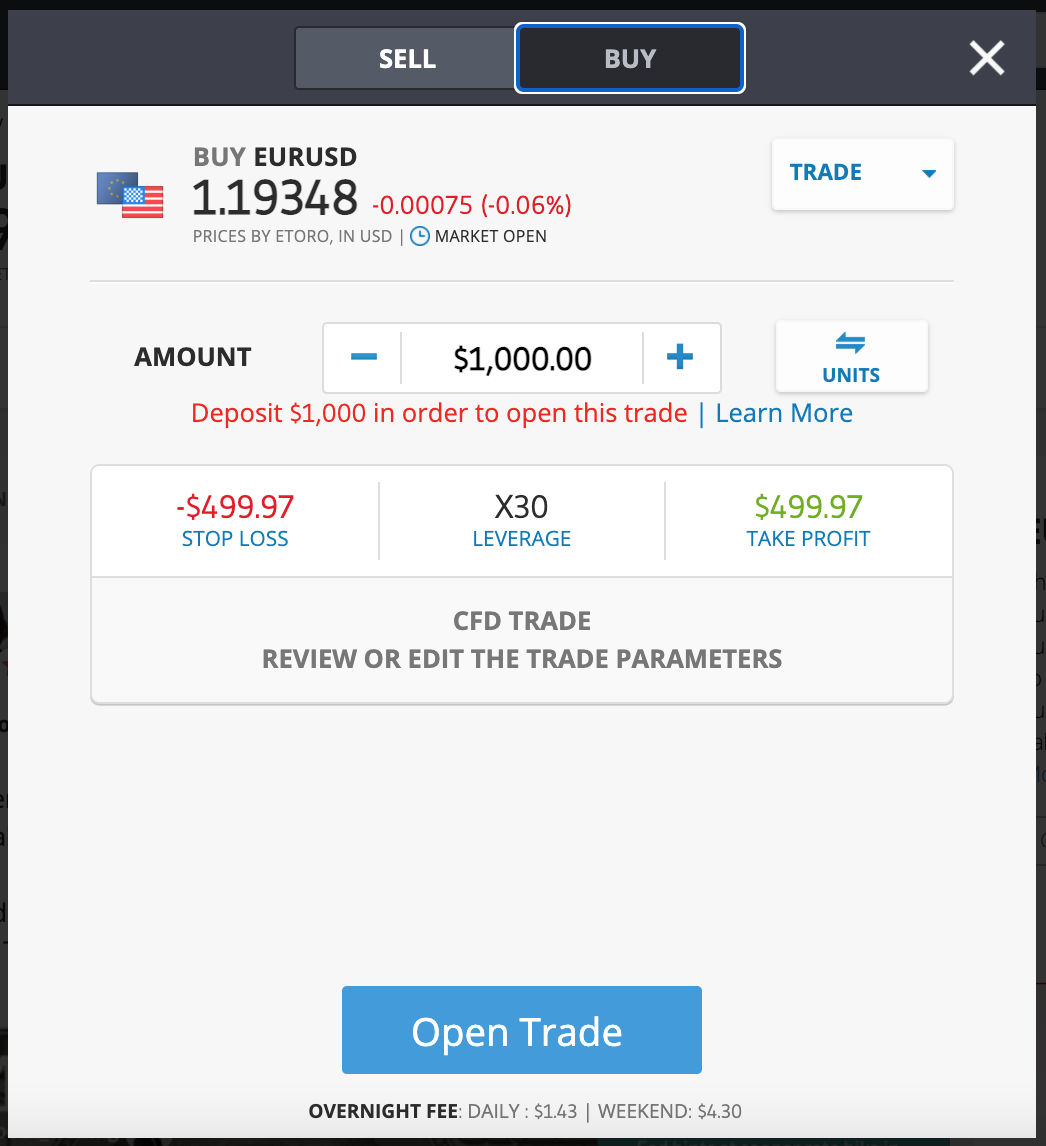
Congratulations! You’ve just placed a forex trade with one of the top FX brokers – all without paying any commissions!
Forex Trading for Beginners Guide – Conclusion
In summary, trading the forex market is a great way to speculate on the value of currencies in a straightforward and quick manner. With so many strategies to employ, traders will never be short of market opportunities. Furthermore, thanks to the technology we have at our fingertips these days, trading the forex market has never been easier – ensuring retail and professional traders can operate in the FX market at all times of the day.
If you’d like to start trading the forex market right away, we’d recommend creating an account with eToro. eToro does not charge any commissions when you place a trade, and spreads are competitive with other top brokers. In addition, eToro also offers an innovative CopyTrader feature that allows you to automate your FX trading – ideal for beginners who wish to learn the market whilst still making a return.
67% of retail investors lose money trading CFDs at this site
